Roger Maris
Roger Eugene Maris (September 10, 1934 – December 14, 1985) was an American professional baseball right fielder. He is best known for setting a new Major League Baseball (MLB) single-season home run record with 61 home runs in 1961; the record remained unbroken until 1998.
| Roger Maris | |||
|---|---|---|---|
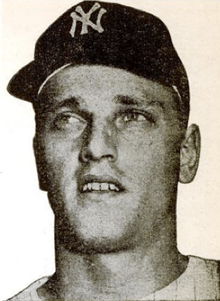 Maris in 1960 | |||
| Right fielder | |||
| Born: September 10, 1934 Hibbing, Minnesota | |||
| Died: December 14, 1985 (aged 51) Houston, Texas | |||
| |||
| MLB debut | |||
| April 16, 1957, for the Cleveland Indians | |||
| Last MLB appearance | |||
| September 29, 1968, for the St. Louis Cardinals | |||
| MLB statistics | |||
| Batting average | .260 | ||
| Home runs | 275 | ||
| Runs batted in | 850 | ||
| Teams | |||
| |||
| Career highlights and awards | |||
| |||
Maris played in the minor leagues from 1953 to 1956, and in the major leagues from 1957 to 1968. He reached the major leagues in 1957 as a player for the Cleveland Indians. He was traded to the Kansas City Athletics during the 1958 season, and to the New York Yankees after the 1959 season. Maris finished his playing career as a member of the St. Louis Cardinals in 1967 and 1968. Maris was an American League (AL) All-Star from 1959 through 1962,[lower-alpha 1] an AL Most Valuable Player in 1960 and 1961, and an AL Gold Glove Award winner in 1960. Maris appeared in seven World Series; he played for Yankees teams that won the World Series in 1961 and 1962 and for a Cardinals team that won the World Series in 1967.
Maris' home run record was controversial. The previous single-season home run record (60, set by Babe Ruth in 1927) was set during a period when MLB teams played 154 games per season. Before Maris broke Ruth's record, the AL baseball season had been extended to 162 games. Maris hit his 61st home run in the last game of the season, which led to questions about the legitimacy of his record.[1] In 1998, Mark McGwire set a new MLB record with 70 home runs; in 2001, Barry Bonds surpassed that mark with 73. Maris continues to hold the American League record for most home runs in a season.
Early years
Roger Eugene Maris was born on September 10, 1934, in Hibbing, Minnesota; in 1955, his father changed the surname from Maras to Maris.[2][3] Roger's parents, Rudolph S. "Rudy" Maras and Ann Corrine "Connie" (née Perkovich) were born in Minnesota, and of Croatian heritage.[4][5][6] Roger's brother Rudolph, who was a year older, developed polio at age 18 in 1951.[7] Roger's parents had a turbulent marriage and divorced in 1960. His father died in Fargo in 1992 at age 81. After Maris retired from baseball, he moved to Gainesville, Florida, where his mother had moved previously. Anne Corrine Maris died in 2004 at the age of 90.[5]
The Maris family moved to Grand Forks, North Dakota, in 1938, and to Fargo, North Dakota, in 1946.[6] Maris entered Fargo Central High School in 1948. In 1950, Maris, a Roman Catholic, transferred to Bishop Shanley High School in Fargo, and graduated from there in June 1952. Maris played both baseball and football for the Shanley Deacons, and, during one 1951 game, returned four kickoffs for touchdowns.[8] He met his future wife, Patricia, in the tenth grade at a high school basketball game.[9] In football, Maris still holds the official high school record for most return touchdowns in a game, with four (two kickoff returns, one punt return, and one interception return).[10]
Minor league baseball career
Maris started playing for the Indians' minor league organization at Fargo (the Fargo-Moorhead Twins) in 1953. He was named rookie of the year in the Northern League, then moved on to Keokuk, Iowa the next season. In four minor league seasons from 1953 to 1956, Maris hit .303 with 78 home runs. In Game 2 of the 1956 Junior World Series, Maris, playing for the Indianapolis Indians of the American Association (Triple-A league), set a record by driving in seven runs.[11] With all five teams for which Maris played in the minors, the clubs' won-loss records would improve from the prior season.[11]
Major league baseball career
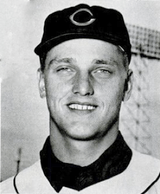
Cleveland Indians (1957–58)
Maris made his major league debut on April 16, 1957, with the Cleveland Indians. Two days later, he hit the first home run of his career, a grand slam off Tigers pitcher Jack Crimian at Briggs Stadium in Detroit.[11] He finished his rookie season with 14 home runs. On June 15, 1958, after playing in 51 games and hitting 9 home runs for the Indians, he was traded to the Kansas City Athletics with Dick Tomanek and Preston Ward for Vic Power and Woodie Held.[12]
Kansas City Athletics (1958–59)
Maris played in 99 games and hit 19 home runs for Kansas City in 1958. In 1959, he played in 122 games and hit 16 home runs; he missed 45 games during the second half of the season as a result of an appendix operation. He was selected to play in the second of two All-Star Games held that year.[13][14] In the late 1950s, Kansas City frequently traded their best young players to the New York Yankees – a practice which led them to be referred to as the Yankees' "major league farm team"[15] – and Maris was no exception. In a seven-player deal in December 1959, he was sent to the Yankees with Kent Hadley and Joe DeMaestri in exchange for Marv Throneberry, Norm Siebern, Hank Bauer, and Don Larsen.[16]
New York Yankees (1960–1966)
In 1960, Maris hit a single, double, and two home runs in his first game as a Yankee. He was named to the AL All-Star roster again and played in both games. He finished the season leading the AL in slugging percentage (.581), runs batted in (112), and extra base hits (64). He also hit 39 home runs and had a .283 batting average.[17]He won the American League's Most Valuable Player award and was recognized as an outstanding defensive outfielder with a Gold Glove Award. The Yankees won the American League pennant, the first of five consecutive pennants, but lost a seven-game World Series to the Pittsburgh Pirates culminating in Bill Mazeroski's dramatic walk-off home run.
1961
In 1961, the AL expanded from eight to ten teams. In the expansion draft, the newly created Los Angeles Angels and Washington Senators [18] were restricted to drafting players from AL rosters. The perceived result was that American League team rosters had become watered down, as players who would otherwise have been playing at AAA, if not lower, were now in the AL. The Yankees, however, were left mainly intact. In order to maintain a balanced schedule, AL owners extended the season from 154 games to 162 games in 1961. (The National League expanded its season to 162 games in 1962.)[19] On January 23, 1961, an Associated Press reporter asked Maris whether the schedule changes might threaten Babe Ruth's single-season home run record; Maris replied, "Nobody will touch it... Look up the records and you'll see that it's a rare year when anybody hits 50 homers, let alone 60."

Yankee home runs began to come at a record pace. One famous photograph lined up six 1961 Yankees, including Mantle, Maris, Yogi Berra and Bill Skowron, under the nickname "Murderers Row", because they hit a combined 165 home runs the previous season (the title "Murderers Row", originally coined in 1918, had most famously been used to refer to the 1927 Yankees). As mid-season approached, it seemed quite possible that either Maris or Mantle, or perhaps both, would break Ruth's 34-year-old home run record. Sportswriters began to play the "M&M Boys" against each other, inventing a rivalry where none existed, as Berra would tell multiple interviewers. More and more, the Yankees became "Mickey Mantle's team" and Maris was ostracized as an "outsider" and "not a true Yankee." Mantle, however, was felled by a hip infection causing hospitalization late in the season, leaving Maris as the single remaining player with the opportunity to break Ruth's home run record.[1]
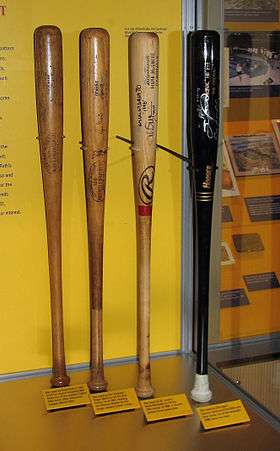
In the middle of the season, baseball commissioner Ford Frick (a friend of Ruth) announced at a press conference that unless Ruth's record was broken in the first 154 games of the season, the new record should be shown separately in the "record books", with some "distinctive mark"[20] next to it indicating it had been done in a 162-game season. The asterisk as such a mark was immediately suggested by New York Daily News sportswriter Dick Young.[20] In spite of its formality, Frick's so-called ruling was merely a suggestion: Major League Baseball had no direct control over any record books until many years later.[20] As he closed in on Ruth’s record, Maris received death threats and NYPD detective Kieran Burke was assigned to watch over him.[21]
Maris had 59 home runs after the Yankees' 154th game and therefore failed to beat Ruth's 60 home runs within the original season length. Maris hit his 61st home run on October 1, 1961, in the fourth inning of the last game of the season, at Yankee Stadium in front of 23,154 fans.[22] Boston Red Sox pitcher Tracy Stallard gave up the record home run, which was caught by fan Sal Durante in the right field bleachers. Maris was awarded the 1961 Hickok Belt as the top professional athlete of the year[23] and won the American League's MVP Award for the second straight year. It is said, however, that the stress of pursuing the record was so great for Maris that his hair occasionally fell out in clumps during the season. Within a few years the asterisk controversy died down and all prominent baseball record keepers listed Maris as the single-season record holder.[20]
1962–1966
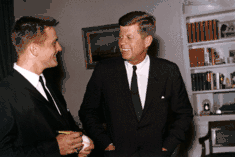
In 1962, Maris made his fourth consecutive All-Star team appearance[24] and his seventh and final All-Star game appearance. He made a game-saving play in the bottom of the ninth inning of Game 7 of the 1962 World Series against the San Francisco Giants. With the Yankees leading 1-0 and Matty Alou on first, Willie Mays doubled toward the right-field line. Maris cut off the ball and made a strong throw to prevent Alou from scoring the tying run; the play set up Willie McCovey's series-ending line drive to second baseman Bobby Richardson, capping what would prove to be the final World Series victory for the "old" Yankees.
In 1963, Maris played in only 90 games, hitting 23 home runs. Maris was injured in Game Two of the 1963 World Series.
In 1964, he rebounded, appearing in 141 games, batting .281 with 26 home runs. Maris hit a home run in Game 6 of the 1964 World Series.[25] In 1965, his physical problems returned, and he had off-season surgery to remove a bone chip in his hand. In 1966, the Yankees' and Maris' fortunes continued to decline as he played most of the season with a misdiagnosed broken bone in his hand. On December 8, 1966, he was traded to the St. Louis Cardinals for Charley Smith.[26]
St. Louis Cardinals (1967–1968)
Maris played his final two seasons with the Cardinals, helping the team to win the 1967 and 1968 pennants and the 1967 World Series. In the 1967 World Series, he hit .385, with a home run, and seven RBI. It was the best World Series performance of Maris’ career.[27]
Later years
In the 1970s and 1980s, Maris and his brother owned and operated Maris Distributing, the Budweiser beer distributorship in Gainesville, Florida (and Ocala, Florida), where he moved after retiring from baseball after the 1968 season. Gussie Busch, who owned both the Cardinals and Anheuser-Busch, got Maris started into the beer business. Maris also coached baseball at Gainesville's Oak Hall High School, which named its baseball field after him in 1990.[28]
Maris was diagnosed with non-Hodgkin lymphoma in 1983. In response, Maris organized the annual Roger Maris Celebrity Golf Tournament to raise money for cancer research and treatment. Maris died of the disease at age 51 on December 14, 1985, at M.D. Anderson Hospital in Houston, Texas. He was buried at Holy Cross Cemetery in Fargo, North Dakota.
Media appearances
Maris and Mantle starred in a 1962 film, Safe at Home!, playing themselves.[29] That year, Maris, Mantle, and Yankee teammate Yogi Berra also made appearances in the film That Touch of Mink, starring Cary Grant and Doris Day.[30]
In 1980, Maris, Mantle, Whitey Ford, Elston Howard, and other former Yankee players made appearances in the film It's My Turn, starring Michael Douglas and Jill Clayburgh.[31] Also in 1980, Maris appeared on the November 11 episode of the variety show Hee Haw along with Barbara Mandrell and Sonny Curtis.
A Roger Maris baseball card was featured in the Star Trek: The Next Generation episode 'The Most Toys' as part of a collection of extremely rare artifacts.
In the 2018 film Green Book, archive footage is featured of Maris hitting a home run against the San Francisco Giants in game 6 of the 1962 World Series.
Pat Maris, wife of Roger Maris, appeared as herself on October 2, 1962 episode of the game show To Tell the Truth. She received three of the four possible votes.[32]
Legacy
Despite the statements made by Commissioner Frick in 1961, no asterisk was subsequently used beside Maris' home run record in any record books. The Guinness Book of World Records did, however, differentiate the Maris home run record and the Ruth home run record as distinct and separate for a number of years. Speaking at the 1980 All-Star Game, he said, "They acted as though I was doing something wrong, poisoning the record books or something. Do you know what I have to show for 61 home runs? Nothing. Exactly nothing."
Maris' single-season Major League home run record was broken by Mark McGwire, who hit 70 in 1998.[23] Barry Bonds went on to set a new Major League record with 73 home runs in 2001.[33] Maris' home run mark was also surpassed by McGwire in 1999 (with 65) and by Sammy Sosa (with 66 in 1998, 63 in 1999, and 64 in 2001).[34] McGwire, Sosa, and Bonds have all been linked to performing-enhancing drugs.[35][36] Maris remains the American League recordholder for most home runs in a season.[37]
Maris received North Dakota's Roughrider Award in 1964.[38] He was inducted into the North Dakota American Legion Baseball Hall of Fame in 1977.[39]
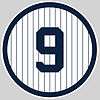 | |
| Roger Maris's number 9 was retired by the New York Yankees in 1984. |
A Roger Eugene Maris plaque dedication and #9 retirement ceremony in Monument Park at Yankee Stadium was held on July 22, 1984 (Old-Timers' Day). The inscribed plaque, subtitled "Against All Odds", calls Maris "A great player and author of one of the most remarkable chapters in the history of major league baseball." Maris participated in the ceremony, wearing a Yankee #9 uniform. Elston Howard (#32), a teammate of Maris, was honored along with Maris.[40]

The Roger Maris Museum, which opened in 1984 at the West Acres Shopping Center in Fargo, and the Roger Maris Cancer Center at Sanford Hospital in Fargo are both named after Maris. The United States Postal Service issued a "Roger Maris, 61 in 61" commemorative stamp on September 17, 1999, as part of the Celebrate the Century series.[41]

Actor Barry Pepper portrays Maris in the 2001 HBO film 61*, directed by Billy Crystal.
In 2005, in light of accusations of steroid use against the three players who had, by then, hit more than 61 home runs in a season (Mark McGwire, Sammy Sosa and Barry Bonds), the North Dakota Senate wrote to Major League Baseball to express the opinion that Roger Maris' 61 home runs should be recognized as the single-season record.[42]
As of 2010, Newman Signs Inc., which holds the naming rights to Newman Outdoor Field in Fargo, continues to use billboard signage to declare Maris as the "legitimate home run king".[43]
Maris was inducted into the Baseball Reliquary's Shrine of the Eternals in 2009.[44]
On September 24, 2011, at Yankee Stadium, the Yankees celebrated the 50th anniversary of Maris' single-season home run record.[45]
Hall of Fame candidacy
To date, Maris had not been elected to the Baseball Hall of Fame.[46]
Sportswriter Greg Hansen criticized baseball writers in the St. Petersburg Independent in 1977 for excluding Maris from the Hall of Fame after Maris received only 72 votes in that year's voting. Hansen noted that there were many Hall of Fame outfielders who had never won two MVP awards, and that no one else had ever hit 61 home runs in a season. "To show you what an injustice this is to the man, Maris finished just a notch ahead of Harvey Kuenn, for crying out loud."[47] Hansen wrote that Maris had resented the media's intrusion on his privacy; he said that Maris's tense relationship with the media had affected the voting.[47] Hansen also wrote that Maris had told him after the voting that he knew he would never get inducted into the Baseball Hall of Fame: "I'll leave the Hall of Fame to the geniuses that vote on it. I will never get in. I have always known that. I will not argue with you about why or why not I should be elected."[47]
In 2011, George Vecsey of The New York Times called Maris "a terrific player for a few brief years".[48] He wrote that while Maris had two seasons where he played at Hall of Fame caliber, and while Maris played in an era that was not influenced by performance-enhancing substances, he did not believe that Maris had career statistics worthy of induction.[48]
The Baseball Hall of Fame established a Golden Era Committee (replacing the Veterans Committee) in 2010 to vote on the possible Hall of Fame induction of previously overlooked candidates among those who were active between 1947 and 1972. Beginning in 2011, this committee voted every three years on ten candidates from the era selected by the Baseball Writers' Association of America's (BBWAA) Historical Overview Committee. Maris did not appear on the Golden Era Committee ballot in 2011 and 2014 (one former player was voted to the Hall of Fame in 2011 and no one was voted in by the committee in 2014).[49][50]
Golden Days Committee
In July 2016, four new committees were established.[51] The Golden Days Era Committee (1950–1969) is scheduled to meet and vote for the first time in December 2020 for the 2021 Hall of Fame induction.[52] Maris is the 24th former player on the Hall of Fame rated list of 85 eligible candidates for the Golden Days Committee Ballot.[53][52]
MLB statistics, awards, achievements, and records
Statistics
Awards and honors
- 7× All-Star (1959²–1962²)
- 3× World Series champion (1961, 1962, 1967)
- 2× AL MVP (1960, 1961)
- 2× AL RBI leader (1960, 1961)
- AL Gold Glove Award (1960)
- Hickok Belt (1961)
- Sporting News Player of the Year (1961)[54]
- AL home run leader (1961)
- New York Yankees No. 9 retired
- Monument Park honoree
Achievements
- All-Star: 1959, 1960 (2 games), 1961 (2 games), 1962 (2 games)
- MLB single season home run champion (1961–1998)
- AL leader in home runs, runs scored, and total bases (1961)
- AL leader in RBIs and extra base hits (1960, 1961)
- AL leader in slugging average (1960)
- AL leader in fielding average as right fielder (1960, 1964)
- NL leader in fielding average as right fielder (1967)
- AL pennant champion team (1960, 1961, 1962, 1963, 1964)
- NL pennant champion team (1967, 1968)
- World Series champion (1961, 1962, 1967)
Records
- AL: Single-season home runs (61, 1961)
See also
Notes
- MLB held two All-Star Games in 1959, 60, 61, and 62.
References
- Service, Bill Modoono, Scripps Howard News. "IT`S BEEN 25 YEARS SINCE NO. 61, BUT MARIS REMAINS BITTER MEMORY". chicagotribune.com.
- "How Much Better and More Honest Roger Maris Seems Today". travel-watch.com. Archived from the original on August 6, 2011.
- "Roger Maris". famously-dead.com.
- Karlgaard, Rich (April 10, 2006). "Roger Maris Belongs in the Hall". Forbes.com.
- Roger Maris's mother dead at 90, UPI.com; accessed August 12, 2016.
- "Roger Maris - Society for American Baseball Research". sabr.org.
- State son worth remembering, The Bismarck Tribune, October 15, 2005; retrieved November 23, 2014.
- Andrew Postman and Larry Stone (1990). The Ultimate Book of Sports Lists. Bantam Books. p. 387.CS1 maint: uses authors parameter (link)
- Mickey Mantle America's Prodigal son by Tony Castro
- "Tales from the Record Book". Archived from the original on September 18, 2012. Retrieved September 19, 2012.
- Clavin, Tom; Peary, Danny (2010). Roger Maris: Baseball's Reluctant Hero. New York: Simon & Schuster. ISBN 978-1-4165-8928-0.
- https://www.baseball-reference.com/players/m/marisro01.shtml
- "Leagues split two All-Star Games in 1959". MLB.com.
- Sandomir, Richard (July 15, 2008). "When Midsummer Had Two Classics" – via NYTimes.com.
- Jeff Katz,The Kansas City A's and the Wrong Half of the Yankees: How the Yankees Controlled Two of the Eight American League Franchises During the 1950s, Maple Street Press, 2007, ISBN 0-9777436-5-9
- Reading Eagle via Google News Archive Search
- https://www.baseball-reference.com/players/m/marisro01.shtml
- The Washington Senators that took the field in 1961 were an expansion team, having replaced the original Senators franchise that had re-located to Minnesota and become the Minnesota Twins.
- "Cutting back to 154 games a season not likely, Halem says". USA TODAY.
- Barra, Allen (October 3, 2001). "The myth of Maris' asterisk". Salon.com. Retrieved November 15, 2014.
- https://www.nydailynews.com/new-york/ny-retired-cop-kieran-burke-obituary-20200326-ew7hnwrvmrdalahbbp2fnuscdy-story.html
- "October 1, 1961 Boston Red Sox at New York Yankees Box Score and Play by Play". Sports Reference, LLC via Retrosheet. Retrieved November 2, 2008.
- "North Dakota bandit steals a $140,000 belt once awarded to Roger Maris". July 26, 2016.
- Sportsdata: Midsummer Classics: Celebrating MLB's All-Star Game, 1959–1962, "all players who were named to the AL or NL roster were credited with one appearance per season." Archived March 30, 2015, at the Wayback Machine
- "Roger Maris Postseason Batting Gamelogs - Baseball-Reference.com".
- "The Day - Google News Archive Search". news.Google.com. Retrieved May 25, 2019.
- "Roger Maris World Series Stats". baseball-almanac.com. Baseball Almanac. 2020. Retrieved February 14, 2020.
- Adelson, Andrea (June 11, 2007). "House That Maris Built stands tall". orlandosentinel.com. Orlando Sentinel. Retrieved February 14, 2020.
- Lieber, Leslie (April 29, 1962). "Mantle and Maris Bat Out a Movie".
- "That Touch of Mink (1962) - IMDbPro".
- "IMDbPro".
- "To Tell the Truth". You Tube. Retrieved April 20, 2020.
- "Hall of Fame countdown: Barry Bonds will have to keep waiting for Hall of Fame entry". USA TODAY.
- "Leaderboarding: The historic home run prowess of Mark McGwire". CBSSports.com.
- https://www.washingtonpost.com/news/early-lead/wp/2018/04/09/mark-mcgwire-says-he-would-have-hit-70-home-runs-without-peds/
- Kroichick, Ron (March 7, 2006). "Book traces Bonds' steroids use to McGwire-Sosa HR race". SFGate.
- "On this date in baseball history: Roger Maris hits record 61st home run in 1961". CBSSports.com.
- news@grandforksherald. com Sep 16th 2011 - 12am. "Past N.D. Rough Rider Award winners". Grand Forks Herald.
- "The American Legion Department of North Dakota, Baseball Hall of Fame, Roger Maris". NDLegion.org. Archived from the original on September 6, 2017. Retrieved May 25, 2019.
- "The Man Who Beat The Babe". Waycross Journal-Herald. July 24, 1984. p. 6. Retrieved April 18, 2012.
- "US Stamp Gallery >> Roger Maris 61 in '61".
- "North Dakota Senate backs Maris resolution". NBCSports.com. Associated Press. April 4, 2005. Archived from the original on March 7, 2012. Retrieved February 18, 2009.
- Bob Von Sternberg (February 5, 2010). "Billboards tout the 61 in '61 clubbed by Maris, "Fargo's golden boy"". Star Tribune. Archived from the original on February 11, 2010. Retrieved June 28, 2010.
- "Shrine of the Eternals – Inductees". Baseball Reliquary. Retrieved 2019-08-14.
- Press, The Associated. "Yankees honor Maris' 61 home run season". Bismarck Tribune.
- "Herrmann: Maris family gets redemption". Newsday.
- Hansen, Greg (February 1, 1977). "Roger Maris". Evening Independent. Retrieved December 3, 2014.
- Vecsey, George (August 20, 2011). "50 years later, Maris's 61-homer season looks even better". The New York Times. Retrieved December 3, 2014.
- "Golden Era Committee candidates announced". Baseball Hall of Fame. Retrieved December 3, 2014.
- Bloom, Barry. "Santo, Hodges among 10 on Golden Era ballot". MLB.com. Retrieved December 3, 2014.
- "Eras Committees". Baseball Hall of Fame.
- "Hall of Stats: Upcoming Elections". www.hallofstats.com.
- "Hall of Stats: Roger Maris". www.hallofstats.com.
- "MLB The Sporting News Pitchers of the Year & The Sporting News Major League Players of the Year". Baseball-Reference.com. Sports Reference LLC. 2020. Retrieved February 14, 2020.
External links
| Wikimedia Commons has media related to Roger Maris. |
- Career statistics and player information from MLB, or ESPN, or Baseball-Reference, or Fangraphs, or Baseball-Reference (Minors), or Retrosheet
- Official website
- Roger Maris on IMDb
- Roger Maris at Find a Grave
- Roger Maris Golf Tournament
| Preceded by Babe Ruth |
Single season home run record holder 1961–1998 |
Succeeded by Mark McGwire |